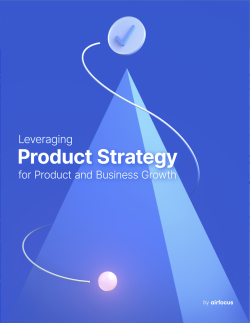When successful products are examined closely, you'll see a solid product strategy.
In a nutshell, product strategy is a high-level plan. It outlines the goal of the organization for the developed product and how to execute the steps towards that goal.
Bringing a whole new product idea is a journey itself, from ideation to development, to testing and all the iterations that come after the initial phase. A product strategy covers a solid plan for each of these stages.
This ensures a successful product in the competitive product landscape.
A detailed product strategy includes the product vision, the user persona, product-market fit, differentiation from the competitors, and product goals for different cycles.
Successful product managers create powerful strategies to align the team around. You will be given many of the pieces and resources by your stakeholders and organization. However, you will be in lead to put these pieces together to craft the strategy.
Without that strategy, your product will fail at any given time.
Why is product strategy important?
It might be an overwhelming task to establish a product strategy, especially for fresh products.
There will be many unknowns or uncertainties while crafting the strategy. Also on the way to developing your products, you will run into a lot of blocked streets and unpredictable changes in the market.
This might make it more challenging to navigate to your goals.
Your product strategy will help you and your team to take the right steps towards each day to make sure you're still in the right direction. This will guide you in uncertain or challenging times.
As a product manager, you will use the product strategy whenever there is confusion or conflict in your team. Think of it like your northern star while you're going through a dark forest. Even when the next town on your route becomes invisible during cloudy days, you will be able to navigate yourself by observing the north star. With it, you can align yourself to make sure to take the right steps on your journey.
Your product strategy additionally helps the organization be responsive to changes in the market conditions make the right decisions.
The product strategy will be the guide to prioritize your product roadmap. As a product manager, you’ll translate the strategy into your roadmaps.
These will hence be actionable items that your development team can execute. Without a solid and agreed strategy, your team will run into prioritizing the wrong items and misuse the limited resources. That's why it's crucial to start with creating the strategy. After your product development strategy is there then you also have a clear picture of what you want to achieve with your development team.

How can you find the right strategy?
Understand your users
Your users are the ultimate people who will be benefiting from the product your development team has created. As a first step, you will need to fully understand who these users are. You need to be engaged with them closely to understand the pain points, frustrations, undesired costs, and situations that they are likely to experience.
To have a full view of these unknowns, you need to conduct user research. Make sure you run surveys to get inputs that you can quantify.
Additionally, engage with your users through interviews which will help you ultimately gather empathy. This then gives you a better understanding of their needs and you learn how your product could help them solve the problems they experience.
Next, create personas to visualize your users. Personas are fictional characters that you create based on your research. They represent different users that will be benefiting from your product. By understanding the use of your product, you will be able to answer critical product questions and create a product that will satisfy the needs of your user.
Understand the problem
To offer a product that is valuable to your user, you need to fully understand the problem that user experiences. At the end of the day, they will use your product to overcome a specific frustration which they were not able to solve themselves. If your product doesn't solve an acute problem, your user might try out the product and leave the next day. By understanding the problem you prevent investing resources for building a solution that has not been needed to begin with.

There will be many opportunities, make sure to choose the best one that fits your product strategy.
Understand opportunities and solutions
Once you have the problem defined, now you can work on ideating on the opportunities and solutions. Make sure to involve everyone in your team in this process and optionally your key stakeholders.
It may be that your software engineers find this irrelevant to their tasks; however, give them the understanding that the ideations work the best when different perspectives are involved.
Additionally, they will be working on the product for a foreseeable future, being part of the solution creation will give them more ownership and motivation in their daily work.
In the ideation session, try to find the answer(s) to the question "How might we solve the problem?".
Conduct a competitive analysis
While working on solutions, you should always have a good understanding of the landscape.
You need to look closer to competitors to understand what differentiates you from others so that you can create your unique value proposition.
Understanding what your competitors have to offer to solve the problems of your user will also give a better knowledge of what are your strengths that you can leverage your product with.
Set your business goals and KPIs
Once you know your user, the solution you want to build, and the landscape your product will be, it's time to set your goals. Your goals should state what your organization will achieve with your product. The goal should be also supported by understanding how you define success by setting KPIs and making them transparent to the whole organization. This assists in aligning with stakeholders and the development team and gives clear prioritization for roadmap items.
Create your roadmap and execute!
Once you have a clear product strategy, things boil down to daily business. You develop, test, iterate to create your path towards a successful product.
For more inspiration for product development strategy, you can check Roman Pichler’s product strategy process.

Asli Aladag

Read also
Create effective product strategy






